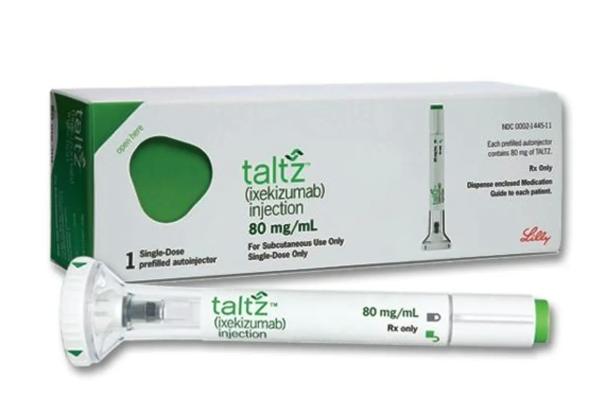Taltz Dosage
Generic name: ixekizumab 80mg in 1mL
Dosage form: injection, solution
Drug class: Interleukin inhibitors
Medically reviewed by Drugs.com. Last updated on Nov 13, 2024.
Testing and Procedures Prior to Treatment Initiation
Perform the following evaluations prior to TALTZ initiation:
- Evaluate patients for tuberculosis (TB) infection. TALTZ initiation is not recommended in patients with active TB infection. Initiate treatment of latent TB prior to initiation of TALTZ.
- Complete all age-appropriate vaccinations as recommended by current immunization guidelines prior to initiating treatment with TALTZ.
Recommended Dosage in Adult Plaque Psoriasis
TALTZ is administered by subcutaneous injection. The recommended dosage in adults with moderate-to-severe plaque psoriasis is 160 mg (two 80 mg injections) at Week 0, followed by 80 mg at Weeks 2, 4, 6, 8, 10, and 12, then 80 mg every 4 weeks.
Recommended Dosage in Pediatric Plaque Psoriasis
TALTZ is administered by subcutaneous injection every 4 weeks (Q4W). The recommended dosage in pediatric patients from 6 to less than 18 years of age with moderate-to-severe plaque psoriasis is based on the following weight categories.
| Pediatric Patient's Weight | Starting Dose (Week 0) | Dose every 4 weeks (Q4W) Thereafter |
| Greater than 50 kg | 160 mg (two 80 mg injections) | 80 mg |
| 25 to 50 kg | 80 mg | 40 mg |
| Less than 25 kg | 40 mg | 20 mg |
Recommended Dosage in Psoriatic Arthritis
The recommended dosage is 160 mg by subcutaneous injection (two 80 mg injections) at Week 0, followed by 80 mg every 4 weeks.
For psoriatic arthritis patients with coexistent moderate-to-severe plaque psoriasis, use the dosing regimen for adult plaque psoriasis.
TALTZ may be administered alone or in combination with a conventional disease-modifying antirheumatic drug (cDMARD) (e.g., methotrexate).
Recommended Dosage in Ankylosing Spondylitis
The recommended dosage is 160 mg by subcutaneous injection (two 80 mg injections) at Week 0, followed by 80 mg every 4 weeks.
Recommended Dosage in Non-radiographic Axial Spondyloarthritis
The recommended dosage is 80 mg by subcutaneous injection every 4 weeks.
Preparation and Administration Instructions
TALTZ is intended for use under the guidance and supervision of a healthcare provider. Adult patients may self-inject or caregivers may give injections of TALTZ after training in subcutaneous injection technique using the autoinjector or prefilled syringe. Safety and effectiveness of pediatric self-administration has not been established. Therefore, TALTZ should be administered to pediatric patients by a healthcare provider or by a caregiver who has received training and demonstrated proper subcutaneous injection technique.
TALTZ 20 mg and 40 mg doses prepared from the TALTZ 80 mg/mL prefilled syringe should only be administered by a qualified healthcare professional.
The TALTZ “Instructions for Use” contains more detailed instructions on the preparation and administration of TALTZ.
Before injection, remove TALTZ autoinjector or TALTZ prefilled syringe from the refrigerator and allow TALTZ to reach room temperature (30 minutes) without removing the needle cap. Inspect TALTZ visually for particulate matter and discoloration prior to administration. TALTZ is a clear and colorless to slightly yellow solution. Do not use if the liquid contains visible particles, is discolored or cloudy (other than clear and colorless to slightly yellow).
Administer each injection at a different anatomic location (such as upper arms, thighs or any quadrant of abdomen) than the previous injection, and not into areas where the skin is tender, bruised, erythematous, indurated or affected by psoriasis. Administration of TALTZ in the upper, outer arm may be performed by a caregiver or healthcare provider.
TALTZ does not contain preservatives, therefore discard any unused product.
If a dose is missed, administer the dose as soon as possible. Thereafter, resume dosing at the regular scheduled time.
2.8 Alternative Preparation Instructions of TALTZ Doses for Pediatric Patients with Plaque Psoriasis Weighing 50 kg or Less
If the 20 mg/0.25 mL or 40 mg/0.5 mL prefilled syringe is unavailable, TALTZ doses of 20 mg or 40 mg for pediatric patients with plaque psoriasis must be manually prepared according to the steps below using only the TALTZ 80 mg/mL prefilled syringe. The preparation and administration of the 20 mg and 40 mg doses should only be performed by a qualified healthcare professional. For additional preparation and administration instructions,.
- Gather the following necessary supplies for preparation:
- 0.5 mL or 1 mL disposable syringe
- Sterile needle for withdrawal
- 27-gauge sterile needle for administration
- Sterile, clear glass vial.
- Expel the entire contents of the prefilled syringe into the sterile vial. DO NOT shake or swirl the vial. Do not add other medications to solutions containing TALTZ.
- Using the 0.5 mL or 1 mL disposable syringe and sterile needle, withdraw the prescribed dose from the vial (0.25 mL for 20 mg; 0.5 mL for 40 mg).
- Remove the needle from the syringe and replace it with a 27-gauge needle prior to administering TALTZ.
Storage of Prepared TALTZ
If necessary, TALTZ 20 mg or 40 mg doses prepared from an 80 mg/mL prefilled syringe may be stored at room temperature for up to 4 hours from first puncturing the sterile vial.
Frequently asked questions
- What are Monoclonal Antibodies and how do they work?
- What are IL-17 Inhibitors and how do they work?
- What are 6 key Taltz side effects to watch out for?
- How does Taltz compare to Cosentyx for psoriatic arthritis?
- How long before Taltz works?
- Can I drink alcohol with Taltz?
- Is weight gain a side effect of Taltz?
- What are the new drugs for plaque psoriasis?
- What causes Plaque Psoriasis?
More about Taltz (ixekizumab)
- Check interactions
- Compare alternatives
- Pricing & coupons
- Reviews (229)
- Drug images
- Side effects
- Patient tips
- During pregnancy
- Support group
- FDA approval history
- Drug class: interleukin inhibitors
- Breastfeeding
Patient resources
Professional resources
Related treatment guides
See also:
Further information
Always consult your healthcare provider to ensure the information displayed on this page applies to your personal circumstances.


